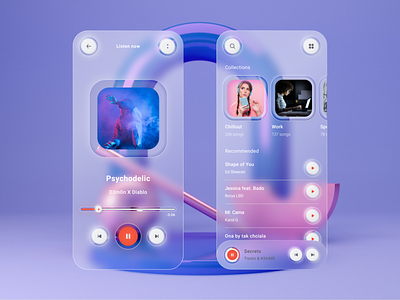Neumorphic & Glassmorphic Mix Music Player
In the realm of digital design, trends come and go, but some concepts stand out for their ability to merge aesthetics with functionality in compelling ways. One such blend is the marriage of neumorphism and glassmorphism, two design styles that have gained popularity in recent years. When applied thoughtfully, these styles can create a unique user experience that is both visually striking and intuitive to navigate. In this article, we'll explore the concept of combining neumorphism and glassmorphism in the design and development of a music player application.
Understanding Neumorphism and Glassmorphism
Before delving into the design and development process, it's essential to understand the principles behind neumorphism and glassmorphism.
Neumorphism, also known as soft UI, is a design trend that aims to create a soft, tactile look reminiscent of skeuomorphic design. It involves using subtle shadows and highlights to mimic the appearance of physical objects, giving them a sense of depth and texture. Neumorphic elements appear as if they are slightly raised or recessed from the background, resulting in a minimalist yet visually appealing aesthetic.
On the other hand, glassmorphism, as the name suggests, draws inspiration from glass-like surfaces. It employs translucent panels, blurred backgrounds, and frosted glass effects to create a sense of depth and realism. Glassmorphic design elements often appear as if they are floating above the background, adding a sense of sophistication and elegance to the interface.
The Fusion of Neumorphism and Glassmorphism in Music Player Design
Combining neumorphism and glassmorphism in the design of a music player application offers a unique opportunity to create a visually stunning and immersive user experience. By carefully integrating elements of both styles, designers can strike a balance between familiarity and innovation, resulting in a design that feels modern yet approachable.
Visual Elements:
In a neumorphic and glassmorphic mix music player, visual elements play a crucial role in shaping the user experience. Soft shadows and highlights are used to create buttons, sliders, and other interactive elements, giving them a tactile feel. These elements appear to be slightly raised from the background, inviting users to interact with them.
Translucent panels and frosted glass effects are employed to overlay album artwork, playlists, and other content, adding depth and dimension to the interface. The use of blurred backgrounds further enhances the sense of depth, making the interface feel more dynamic and immersive.
User Interface:
The user interface of a neumorphic and glassmorphic mix music player is designed to be intuitive and easy to navigate. Clear typography and iconography help users quickly identify and access different features and functions. Smooth animations and transitions add polish to the interface, creating a seamless user experience.
Functionality:
Beyond its visual appeal, a music player application must also offer robust functionality. In a neumorphic and glassmorphic mix music player, this means providing essential features such as playback controls, playlist management, and audio equalization options. Additionally, advanced features like personalized recommendations and social sharing integrations can further enhance the user experience.
Development Considerations
When developing a neumorphic and glassmorphic mix music player, several technical considerations come into play. Ensuring cross-platform compatibility, optimizing performance, and maintaining security are all critical aspects of the development process.
Cross-Platform Compatibility:
To reach the widest possible audience, it's essential to develop the music player application for multiple platforms, including web, mobile, and desktop. This requires careful consideration of platform-specific design guidelines, APIs, and development frameworks. Using responsive design techniques can help ensure a consistent user experience across different devices and screen sizes.
Performance Optimization:
In a music player application, performance is paramount. Users expect smooth playback, fast loading times, and responsive interactions. To achieve this, developers must optimize the application's codebase, minimize resource usage, and leverage caching and prefetching techniques. Additionally, implementing lazy loading for large media files can help reduce initial load times and improve overall performance.
Security:
Security is another crucial consideration in the development of a music player application, particularly when handling user data and sensitive information. Implementing robust authentication and authorization mechanisms, encrypting data in transit and at rest, and regularly updating dependencies and libraries are essential steps in ensuring the application remains secure against potential threats.
Conclusion
In conclusion, the fusion of neumorphism and glassmorphism in the design and development of a music player application offers a unique opportunity to create a visually stunning and immersive user experience. By combining elements of both styles, designers and developers can create an interface that is not only aesthetically pleasing but also intuitive to navigate and functionally robust. With careful attention to detail and a focus on cross-platform compatibility, performance optimization, and security, a neumorphic and glassmorphic mix music player has the potential to delight users and set new standards for digital design in the music industry.
Contact US for the best design and development.




